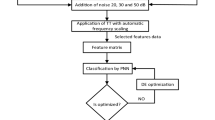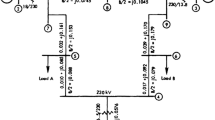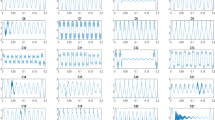Abstract
The significance of detection and classification of power quality events that disturb the voltage and/or current waveforms in the electrical power distribution networks is well known. Consequently, in spite of a large number of research reports in this area, a research on the selection of proper parameter for specific classifiers was so far not explored. The parameter selection is very important for successful modelling of input–output relationship in a function approximation model. In this study, probabilistic neural network (PNN) has been used as a function approximation tool for power disturbance classification and genetic algorithm (GA) is utilised for optimisation of the smoothing parameter of the PNN. The important features extracted from raw power disturbance signal using S-Transform are given to the PNN for effective classification. The choice of smoothing parameter for PNN classifier will significantly impact the classification accuracy. Hence, GA based parameter optimization is done to ensure good classification accuracy by selecting suitable parameter of the PNN classifier. Testing results show that the proposed S-Transform based GA–PNN model has better classification ability than classifiers based on conventional grid search method for parameter selection. The noisy and practical signals are considered for the classification process to show the effectiveness of the proposed method in comparison with existing methods.







Similar content being viewed by others
References
S. Santoso, E.J. Powers, W. Grady, Power quality disturbance identification using wavelet transformers and artificial neutral network, in Proceedings of the International Conference on Harmonic and Quality of Power (Las Vegas, NV, 1996), pp. 615–618
Z.L. Gaing, Wavelet-based neural network for power disturbance recognition and classification. IEEE Trans. Power Del. 19(4), 1560–1568 (2004)
H. He, J.A. Starzyk, A self-organizing learning array system for power quality classification based on wavelet transform. IEEE Trans. Power Del. 21(1), 286–295 (2006)
A.M. Gaouda, M.M.A. Salama, M.K. Sultan, A.Y. Chikhani, Power quality detection and classification using wavelet-multiresolution signal decomposition. IEEE Trans. Power Del. 14(4), 1469–1476 (1999)
L. Angrisani, P. Daponte, M. D’Apuzzo, A. Testa, A measurement method based on the wavelet transform for power quality analysis. IEEE Trans. Power Del. 13(4), 990–998 (1998)
S. Santoso, E.J. Powers, W.M. Grady, P. Hofmann, Power quality assessment via wavelet transform analysis. IEEE Trans. Power Del. 11(2), 924–930 (1996)
Gaing Zwe-Lee, Wavelet-based neural network for power disturbance recognition and classification. IEEE Trans. Power Deliv. 19, 1560–1567 (2004)
D.E. Goldberg, Genetic Algorithms in Search Optimization and Machine Learning (Addison-Wesley, Reading, MA, 1989)
P. Janik, T. Lobos, Automated classification of power-quality disturbances using SVM and RBF networks. IEEE Trans. Power Deliv. 21, 1663–1669 (2006)
B.K. Panigrahi, V.R. Pandi, Optimal feature selection for classification of power quality disturbances using wavelet packet-based fuzzy k-nearest neighbor algorithm. IET Gener. Transm. Distrib., 3(3), 296–306 (2009)
S.M. LaValle, M.S. Branicky, On the relationship between classical grid search and probabilistic roadmaps. Int. J. Robot. Res. 23(7–8), 673–692 (2002)
R.G. Stockwell, L. Mansinha, R.P. Lowe, Localization of the complex spectrum: The S-transform. IEEE Trans. Signal Process. 44(4), 998–1001 (1996)
S. Mishra, C.N. Bhende, B.K. Panigrahi, Detection and classification of power quality disturbances using S-Transform and probabilistic neural network. IEEE Trans. Power Deliv. 23(1), 280–287 (2008)
M.V. Chilukuri, P.K. Dash, Multiresolution S-Transform-based fuzzy recognition system for power quality events. IEEE Transa. Power Deliv. 19(1), 323–330 (2004)
D.F. Specht, Probabilistic neural networks. Neural Netw. 3(1), 109–118 (1990)
D. Arthur Little, “Power Quality Market Assessment”, final report EPRI TR-104372, prepared for Electric Power Research Institute, October 1994
I.W.C. Lee, P.K. Dash, S-Transform-based intelligent system for classification of power quality disturbance signals. IEEE Trans. Ind. Electron. 50(4), August 2003
M. Zhang, K. Li, Y. Hu, A real time classification method for power quality disturbances. Electr. Power Syst. Res. 81(1), 660–666 (2011)
Author information
Authors and Affiliations
Corresponding author
Rights and permissions
About this article
Cite this article
Manimala, K., Selvi, K. Power Disturbances Classification Using S-Transform Based GA–PNN. J. Inst. Eng. India Ser. B 96, 283–295 (2015). https://doi.org/10.1007/s40031-014-0144-6
Received:
Accepted:
Published:
Issue Date:
DOI: https://doi.org/10.1007/s40031-014-0144-6




